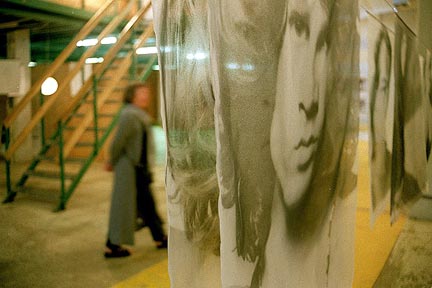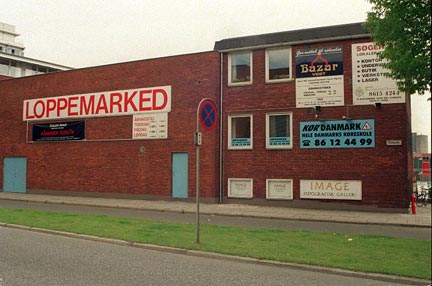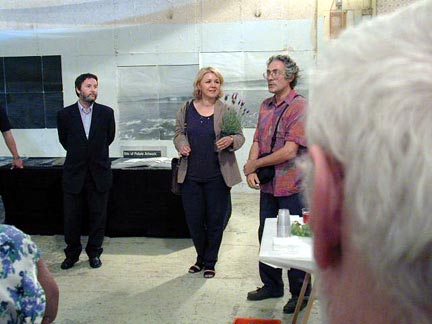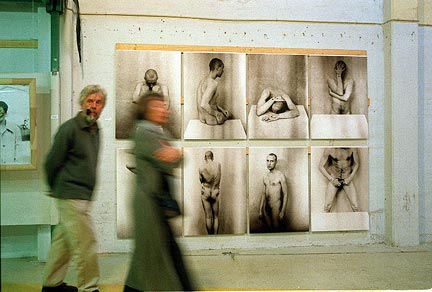
Aarhus, Galleri Image, Loppehallen. Opening of the "Together Again?" exhibition, August 27, 1999, Works by Robo Kocan. Photo M. Grygiel
Review in Aarhus Stiftstidende
by Bjarne Baekgaard, August 30, 1999Identity through the lens
"Identities". This title by the Slovak photographer Martin Tiso defines the theme not only for his own works but for the entire photographic exhibition "Together Again?", Galleri IMAGE's contribution to this year's Aarhus Festival theme "Ten years after the fall of the wall."
For this is what it is all about - identity. Who am I? Who are we? Where do we come from? Where are we going? These are the questions which, gathered through camera lenses, have become the most important business for the majority of these photographers.
There are various nations - Poland, Estonia, Slovakia, Latvia, and Hungary - but the situation is, with local modifications, the same. The path of history hit a wall, it then fell, and the work of reconstruction has been in progress since.
And for the individual East European, the reconstruction of an (of a new?) identity.
Minor Key
Traditional East European historical melancholy, played in a minor key, sets a serious melodious foundation no matter where the photographer comes from.
So even though we are "together again" with them, the question mark of the exhibition's title is underlined: Are we together again? The historical roots in the east are not the same as those in the west, and East Europeans must reach an accord with their own roots in their attempts today to find their identity tomorrow.
The focus of the exhibition is also on today's works looking towards tomorrow. Daily life is captured in the search for identity - for example in Dezsö Szabo's multiplicity of snapshots of me, them, us. Whereas a single person is in focus as a symbol of the search for identity in for example Mark Raidepere's merciless uncovering of the defenseless body and in Arne Antums-Janson's excoriated "Disappearing within oneself".
Both Taave Tuutma and Robo Kocan use humor in their search for common identity through the individual. Starting with a (self) portrait, they send the individual East European out into the world that opened up after the fall of the wall.
Poland's Pawel Zak creates his own unique form of identity with his meticulous poetic world, populated by beautiful still-lifes or tableaux from the fantasy world of childhood.
Relevant Question
"Together again?" asks the exhibition. That this is a relevant question is documented by the dominant themes used by the photographers chosen for this exhibition. And it is worth mentioning that these photographers have not been included here because of a choice of the identity theme, but rather they have been chosen by various curators acting independently in their own countries.
The question "together again?" is difficult to answer once and for all, even ten years after the fall of the wall. Sometimes the answer is denial, sometimes affirmation, sometimes a hesitant yes, sometimes "I guess not".
But "Together Again?" gives such good attempts at an answer, that there is but one answer to the question, "should you see this unique photo exhibition". The answer is unequivocally "Yes."
Aarhus, Galleri Image, Loppehallen. Photo M. Grygiel
From a review in "Weekendavisen"
by Poul Erik Tøjner, Sept. 3, 1999...Last, but not least - although it is not of great stature - we pass by the almost virtual and perennially hard fighting Galleri IMAGE, still housed in a confused venue near "Spain" (which is a street in Aarhus). Here they show a group of East European photographers gathered under the title "Together Again". The works range from an anecdotal private world of snapshots via estheticized staged photography to the conceptual. There is no unity of anything, no common thread, the setting is humble, it is as if everything but the wall has fallen down.
Aarhus, Galleri Image, Loppehallen. Opening of the "Together Again?" exhibition, August 27, 1999. From left: Marek Grygiel, Beate Cegielska, Saul Shapiro. Photo Jura Plietsik (digital)
From a review in "Information"
by Gitte Ørskou Madsen, Sept. 4, 1999Visual art has always lived the life of a recluse during the Aarhus Festival. After the theaters, dancers, musicians, and street artists have given the Festival that touch of creative dynamics that is part of its renommé, it is as if visual art quietly retires from the limelight into dark exhibition spaces frequented only by the few.
There is always an event happening, so a visit to the visual arts is postponed indefinitely. Visual art is said to require time and quiet. So much so that art life in Aarhus, except for a few spectacular exceptions, the last few years has quietly resigned itself to its fate and put on shows that they would have done anyway, even without the Festival theme as a fruitful input.
This year's theme, "Ten years after the fall of the wall", has however brought forth surprisingly talented exhibitions to the empty venues. Ingenuity is greater and ambitions loftier than have been seen for some time. Not so much because of the political implications of Eastern Europe's greatness and decline, but more because of the promise held for visual art in the possibilities of looking back on history.
The retrospective exhibition and its historical traces have always been gourmet food for visual art, which can respond both in scale and in depth.
...........
There are also many artists represented at Image Fotografisk Galleri. Five curators from Estonia, Latvia, Poland, Slovakia, and Hungary have chosen 12 young photographers whose works are presented in scenography by the Czech artist Jura Pliestik under the title Together Again?
The rhetorical part of this question refers to the fact that Galleri Image in 1990 exhibited a group of East European artists, and today's show asks if the political and social changes can be read in these young artists' works. This is of course a relevant question in that art in a historical perspective is that place where new identity can be deciphered.
Identity is also the key word for many of these artists. Robo Kocan from Slovakia has taken a series of self-portraits, printed them on silk, and then hung them behind portraits of contemporary icons - Jim Morrisson, Woody Allen, Stalin. He seems to be saying that identity is of a changeable character. It remains unsaid if it is a young man's or a nation's search for identity he is exposing.
For Mark Raidepere from Estonia, identity lies just under the surface in the unclothed skin's vulnerability. In a series of unsharp but seductive self-portraits he poses naked, with burn marks from cigarettes on his body as an indication of the fact that it is first through pain that a human feels himself.
Realism and dream
Perhaps the exhibition's rhetorical question is clearest in the works of Hungarian Miklos Erhardt and Dominic Hislop, who have given cameras to the homeless of Budapest so that they could document and comment upon their daily life.
With the shameful eyes of inquisitiveness these pictures take us on an expedition through a class in society that obviously has no visual arts culture. But this daily life also contains positive moments when these homeless take their own photographs and are not reduced to being merely picturesque objects. Perhaps energetic, positive action is the road to the future, also for Eastern Europe.
Aarhus, Galleri Image, Loppehallen. Opening of the "Together Again?" exhibition, August 27, 1999. Photo: M. Grygiel
Galleri Image ©1999 Toldbodgade 8, 8000 Aarhus C, Denmark.



